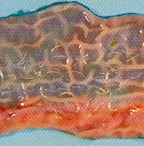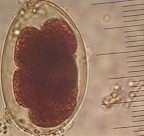Globocephalus is a genus of hookworms that affects swine and wild boars worldwide. Prevalence may be very high in endemic regions. The most relevant species of veterinary importance is Globocephalus urosubulatus.

The disease caused by worm of this genus is called globocephalosis.
Neither ruminants (cattle, sheep, etc.), nor dogs or cats are affected by species of this genus.
Are pigs infected with Globocephalus worms contagious for humans?
NO. The reason is that these worms are not parasites of humans. <
You can find additional information in this site on the general biology of parasitic worms and/or roundworms.
Final location of Globocephalus worms
Predilection site of adult Globocephalus worms is the small intestine.
Anatomy of Globocephalus worms

Globocephalus adults are rather small worms, about 6 to 8 mm long, whereby females are larger than males. As other roundworms the body of these worms is covered with a cuticle, which is flexible but rather tough. The worms have no external signs of segmentation.
They have a tubular digestive system with two openings. They have a mouth capsule with teeth to suck blood. They also have a nervous system but no excretory organs and no circulatory system, i.e. neither a heart nor blood vessels. Males have two spicules for attaching to the female during copulation.
The eggs are ovoid, ~35x60 micrometers, with a thin membrane and contain 4 to 8 cells when shed with the feces.
Life cycle of Globocephalus worms
The life cycle of these worms is not completely elucidated. Most probably they have a direct life cycle without intermediate hosts. Eggs shed with the feces of the infected host release larvae in the environment (also indoors!) that develop to infective L3-larvae in 8 to 12 days.
These infective larvae are not very resistant in the environment: they do not support direct sunlight, dryness and low temperatures. Usually they do not survive long periods at temperatures below 0°C, i.e. they cannot overwinter in the soil in cold regions of the Northern Hemisphere.
Pigs become infected after ingesting such infective larvae, but piglets can also become infected through the skin. Ingested larvae migrate from the gut to the heart, the lungs, the trachea, the esophagus and back to the gut where they complete development to adults, attach to the gut's lining to suck blood, and start producing eggs.
Harm caused by Globocephalus infections, symptoms and diagnosis
Globocephalus infections are not frequent, but massive infections can cause significance damage in endemic regions. These worms attach to the gut's mucosa to suck blood and change frequently the attachment site. This causes numerous small bleedings and lesions in the mucosa. Digestion is disturbed (reduce weight gains or even weight loss) with anemia and hypoproteinaemia.
Diagnosis is confirmed by detection of typical strongylid eggs in the feces.
Prevention and control of Globocephalus infections
Systematic and thorough removal of all manure and keeping the facilities dry reduces the risk of infection.
Numerous anthelmintics are effective against adult worms, e.g. several benzimidazoles (albendazole, fenbendazole, flubendazole, mebendazole, oxfendazole, etc.), levamisole, as well as several macrocyclic lactones (e.g. abamectin, doramectin, ivermectin, moxidectin), the latter are usually also effective against migrating larvae. However, some dewormers may not be approved for Globocephalus control in certain countries.
Depending on the country most of these anthelmintics are available for oral administration as feed additives or drenches. Levamisole and most macrocyclic lactones are usually also available as injectables.
There are so far no true vaccines against Globocephalus worms. To learn more about vaccines against parasites of livestock and pets click here.
Biological control of Globocephalus worms (i.e. using its natural enemies) is so far not feasible. Learn more about biological control of worms.
You may be interested in an article in this site on medicinal plants against external and internal parasites.
Resistance of Globocephalus worms to anthelmintics
So far there are no reports on resistance of Globocephalus worms to anthelmintics.
This means that if an anthelmintic fails to achieve the expected efficacy, chance is very high that either the product was unsuited for the control of Globocephalus worms, or it was used incorrectly.
Learn more about parasite resistance and how it develops.
|
Ask your veterinary doctor! If available, follow more specific national or regional recommendations for Globocephalus control. |